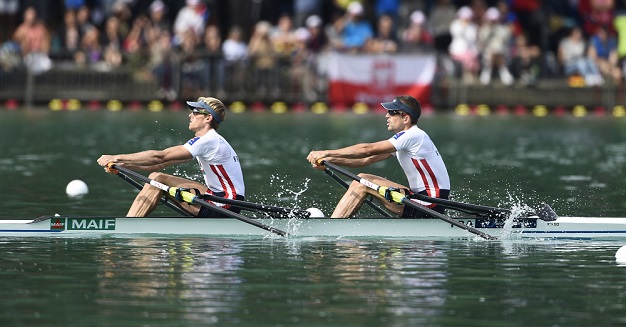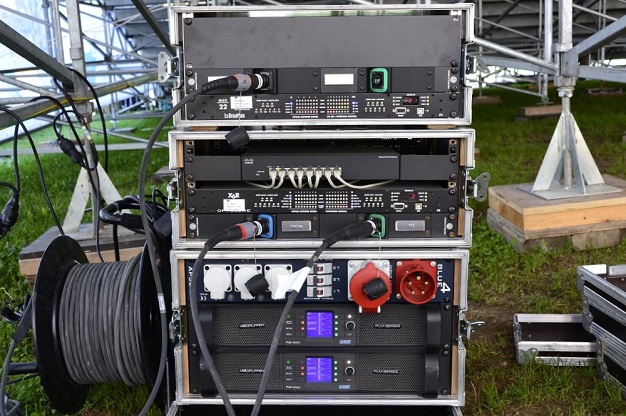Major event specialists GB4D, have upgraded their BroaMan optical fibre network in time for the International Rowing Championships (IRC) which took place recently along a 2km stretch of natural lake in Aiguebelette, France.
It is not the first time that Gilles Bouvard’s company has worked at this location in Savoie, having provided network coverage for a world cup competition on the same site in June 2014. But once the Aiguebelette 2015 organising committee had tendered successfully for this year’s World Championships, they needed to find partners to realise the extreme technical challenges of this broadcast event on a course whose infrastructure had now been revised.
“It was the BroaMan and Optocore optical fibre technology that enabled us to win the contract to create this AV network and provide consultancy,” confirmed Gilles. “The athletes’ village was located 700m from the finish and there were complex audio and video requirements at both spaces.”
To ensure the organizing committee made the right choice for its technical service provider, they had first consulted France TV, who had TV rights for the event. Explaining the scope of the requirement, Gilles Bouvard stated, “Our task was to provide an optical fibre transport solution, with multiplexed HD video and audio signals via Optocore and BroaMan devices. We were selected on the recommendation of France TV, for the quality of our design and the proposed implementation.”
They realised the entire distribution of HD video signals at both locations as well as the full sound reinforcement for the event. “Thanks to the fibre, we were also able to build the computer network for publishing the results collected by Swiss Timing, who managed the timekeeping.
This event provided the perfect opportunity for GB4D to enhance their existing system, comprising four Mux22 devices.
There were two sites from which signals needed to be distributed and at both sites the main points were all distributed geographically, in entirely opposite directions from each other. A ‘star’ distribution system thus became imperative. GB4D’s system in fact allows an even more complex topology — a mixture of dual star — with two main distribution and routing hubs. “In addition to the video, the sound also needed to be distributed — but not necessarily to the same points as the video,” Gilles said. “With the number of audio and video signals to be transmitted only Route66 routers could provide a technical solution for both Broaman and Optocore.”
He thus added two Route66 routers, which have 16 Video IN and 24 video OUT, and are capable of 66 channels of routing, signal repeating, as well as signal conversion between electric and optical. Standards supported include 3G/HD/SD-SDI, MADI, Ethernet, Optocore as well as optical signals from third party devices (eg SMPTE cameras). In this instance they were connected to four satellites, comprising two Mux22 (4-in / 4-out SDI with Optocore); two Repeat 48 (4-out SDI with two fibre tunnels to connect an Optocore device).
“We can transport four video In and four video Out between the two routers, with the possibility to distribute video and audio signals to 10 BroaMan devices located throughout the site. This also allowed us to expand the Optocore loop through BroaMan CWDM multiplexing technology.”
In fact the new set-up enabled GB4D to distribute four video channels to 40 video outputs. “Thanks to the routing system we were able to choose which video went to which output.”
With the use of Optocore Control software GB4D could not only monitor and control audio patching and signal status, but also monitor and control the complete video routing. All crosspoints could be changed in real time with no delay. The software also enabled status monitoring of any single system component from one main control place, and thanks to this, GB4D were always in control despite the system complexity and the long distance between the devices.
For the event itself, one Route 66 was located in the control tower at the finish, with the other in the competitors’ area, with the first enabling them to recover the France Television signals, Swiss Timing (timekeeping), and Great Big Events’ giant screen video signals.
From the control room, they had to distribute the sound and imagery for the public areas, the VIP area, the giant screens, as well as the video to the press room, sound for the gallery TV pictures and radio commentators image to FISA — as well as the Ethernet network for remote amplifiers and the LAN for printing results. For the athletes’ areas, the signal distribution requirements were similar.
Gilles Bouvard had worked closely with BroaMan support technicians in Munich to validate the design. “While routing technology offers huge possibilities, implementation is complex and upon delivery of the equipment, BroaMan conducted training. However, the installation went smoothly and there were no technical issues,” confirms Gilles.
And the overall advantages of the BroaMan technology? “It is the fact that it can create a large virtual hub where video, audio, data, DMX and Ethernet are available everywhere. By using the fibres with four strands the world opens up to you, the possibilities are endless!” The extra strands provides the opportunity for Optocore redundancy for instance, when there is no tunnel available on Broaman equipment.
“The organising committee was delighted with the quality of the signal transmission, and we received several plaudits from consultants saying that we made everything so easy.
“We will continue to extend this multi-format AV signal delivery, to show the full capacity of what can be achieved; but these advanced networks depends on us undertaking further major global events, such as we have delivered in Kuwait and for Radio France in Paris. With this technology we have the innovative tools to accomplish this.”


